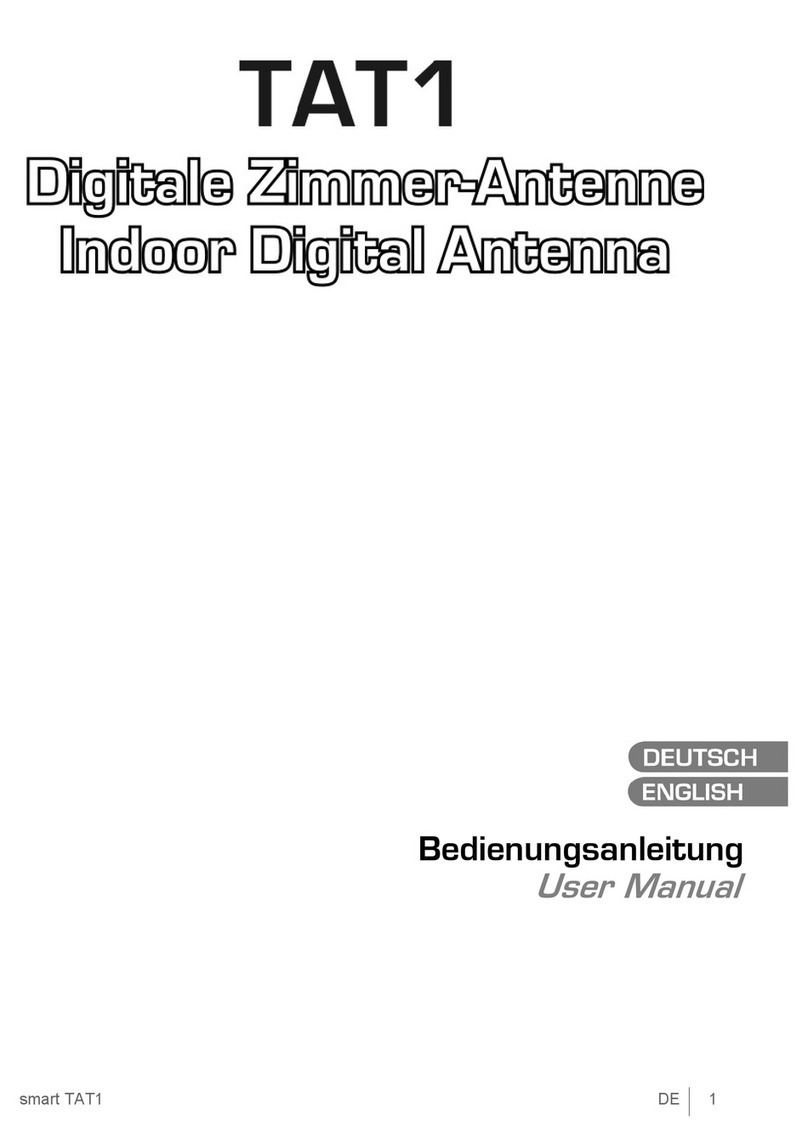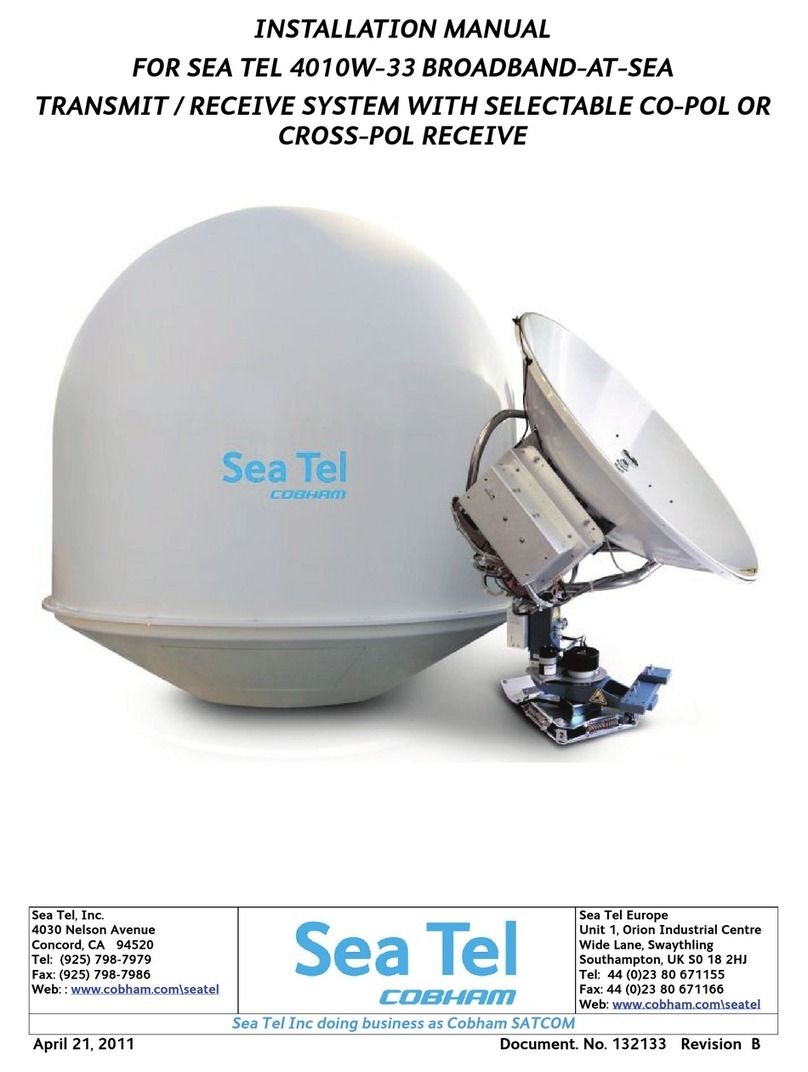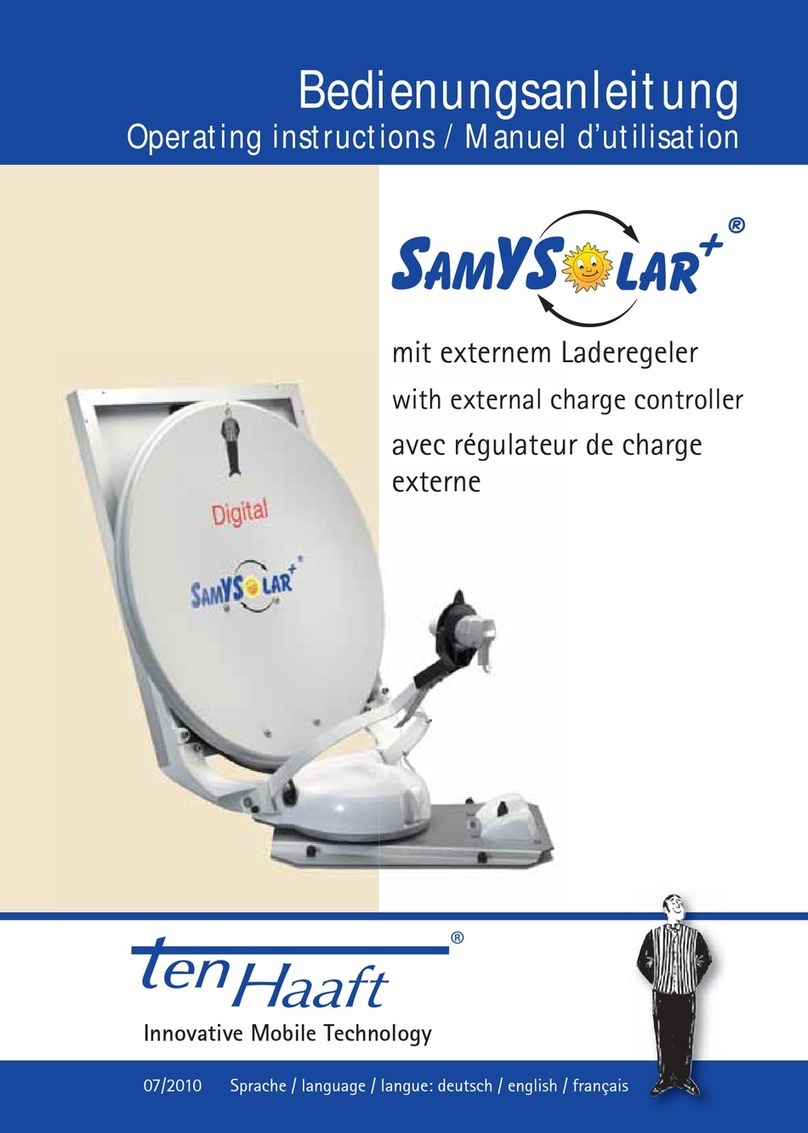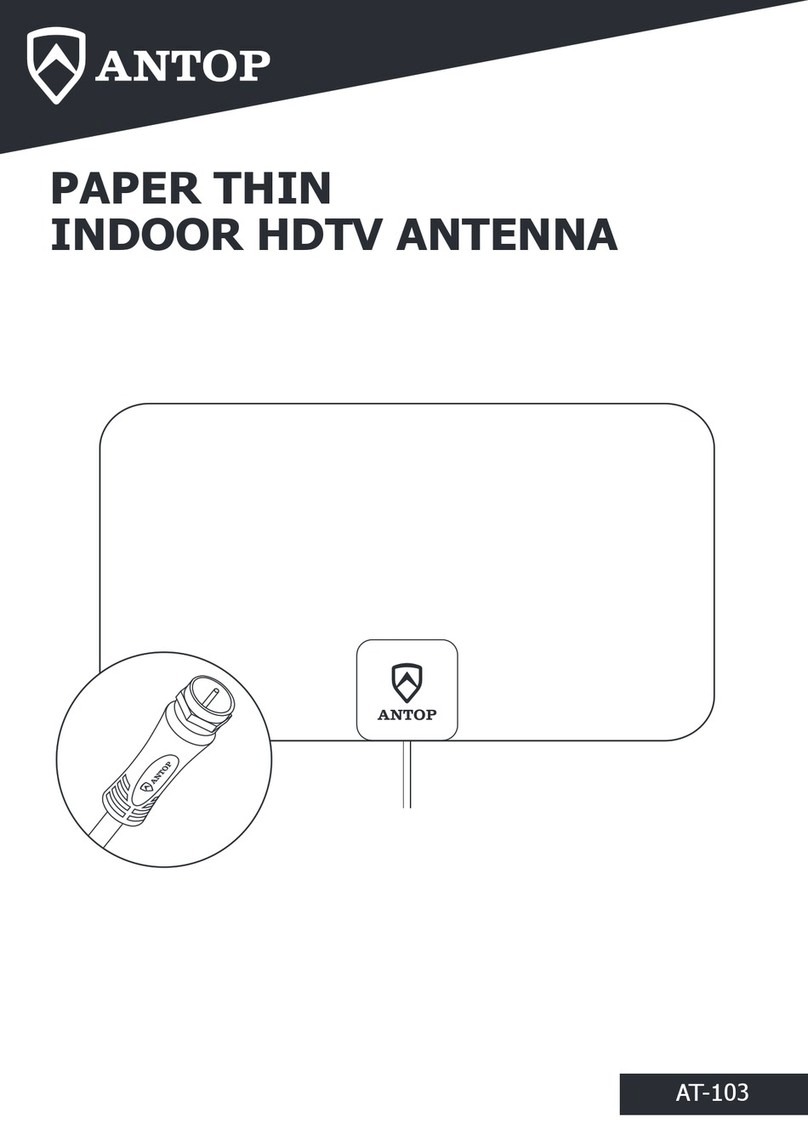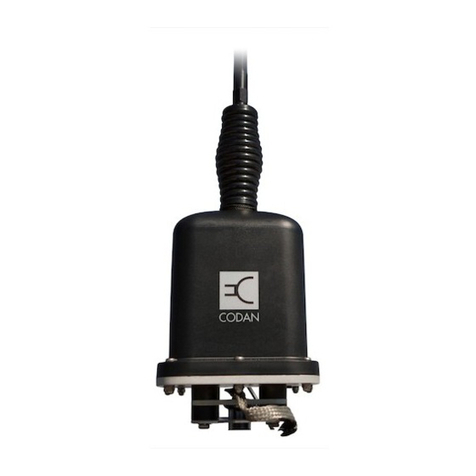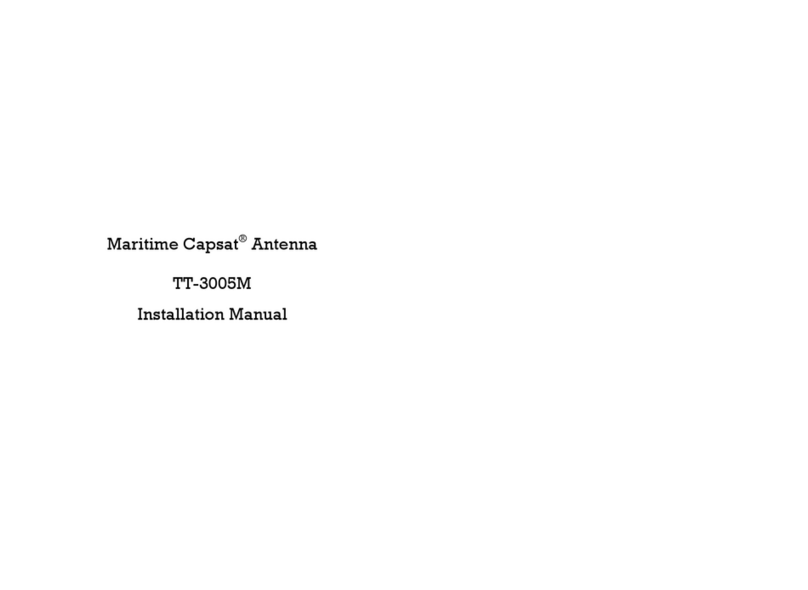Skyware Type 960 .96 Meter Class I and II Antenna... User manual

Assembly Instructions
Type 960 .96 Meter Class I and II Antenna System
Type 123 1.2 Meter Class I and II Antenna System
with Factory Assembled Az/El Cap Mount
8000842-01
Skyware Global
1315 Industrial Park Drive
Smitheld, NC 27577 USA
Telephone: +1-919-934-9711
Internet: www.skywareglobal.com
Printed in U.S.A.
04/11 8000842-01 Rev G EC-01063
™

1
Skyware Global
VERY SMALL APERTURE TERMINAL (VSAT) PRODUCTS
TWELVE (12) MONTH LIMITED WARRANTY
Seller warrants that all Sky ware Global manufactured VSAT products are transferred rightfully and with good title; that they are free from
any lawful security interest or other lien or encumbrance unknown to Buyer. Seller also warrants that for a period of twelve (12) months
from the date of shipment from Seller’s factory, all its VSAT products shall be free from defects in material and workmanship which arise
under proper and normal use and service. Buyer’s exclusive remedy hereunder is limited to Seller’s correction (either at its plant or at
such other place as may be agreed upon between Seller and Buyer) of any such defects by repair or replacement at no cost to Buyer,
except for the costs of any transportation in connection with the return of the defective VSAT products to be replaced or repaired, and
the costs to remove and/or reinstall the products, which shall be borne by Buyer. The limited warranty period shall not be extended
beyond its original term with respect to any part or parts repaired or replaced by seller hereunder.
This warranty shall not apply to VSAT products which (i) have been repaired or altered in any way so as to aect stability or
durability, (ii) have been subject to misuse, negligence or accident, (iii) have been damaged by severe weather conditions such as
excessive wind, ice, storms, lightning, or other natural occurrences beyond Seller’s control; (iv) have presented damages, defects or
nonconformances caused by improper shipping, handling or storage, and (v) have not been installed, operated or maintained in
accordance with Seller’s instructions.
Buyer shall present any claims along with the defective VSAT product(s) to Seller immediately upon failure Non-compliance with any
part of this warranty procedure may invalidate this warranty in whole or in part.
SELLER MAKES NO WARRANTY, EXPRESS OR IMPLIED, OTHER THAN AS SPECIFICALLY STATED ABOVE. EXPRESSLY EXCLUDED
ARE ANY IMPLIED WARRANTIES OF MERCHANTABILITY OR FITNESS FOR A PARTICULAR PURPOSE. THE FOREGOING SHALL
CONSTITUTE ALL OF SELLER’S LIABILITY (EXCEPT AS TO PATENT INFRINGEMENT) WITH RESPECT TO THE VSAT PRODUCTS. IN
NO EVENT SHALL SELLER BE LIABLE FOR ANY LOSS OF PROFITS OR REVENUE, LOSS OF USE, INTERRUPTION OF BUSINESS, OR
INDIRECT, SPECIAL, CONSEQUENTIAL OR INCIDENTAL DAMAGES OF ANY KIND AS A RESULT OF THE USE OF THE
PRODUCTS MANUFACTURED BY SELLER, WHETHER USED IN ACCORDANCE WITH THE INSTRUCTIONS OR NOT. UNDER
NO CIRCUMSTANCES SHALL SELLER’S LIABILITY TO BUYER EXCEED THE ACTUAL SALES PRICE OF THE VSAT PRODUCTS
HEREUNDER.
In some jurisdictions, Buyer may have other rights under certain statutes that may imply non-excludable warranties. No representative is
authorized to assume for Seller any other liability in connection with the VSAT products.
DATE DESCRIPTION REVISION
08/06 ECN 9007484 Rev B
11/07 5075515 Rev C
05/08 5078314 Rev D
09/08 5075934 Rev E
01/10 654 Rev F
04/11 EC-01063 RevG
MANUAL REVISION HISTORY
WARRANTY
DO NOT DISCARD CONTENTS
The product in this packaging was placed in the market after August 13, 2005. Its components must not be discarded with
normal municipal or household waste.
Contact your local waste disposal agency for recovery, recycling, or disposal instructions.

LAW: Installation and installer must meet local codes and ordinances regarding safety! Installation of this product should be performed only
by a professional installer and is not recommended for consumer Do-It-Yourself installations.
DANGER: WATCH FOR WIRES! Installation of this product near power lines is extremely dangerous and must never be attempted. Installa-
tion of this product near power lines can result in death or serious injury! For your own safety, you must follow these important safety rules.
Failure to follow these rules could result in death or serious injury.
1. Perform as many functions as possible on the ground.
2. Watch out for overhead power lines. Check the distance to the power lines before starting installation. Stay at least 6 meters (20 feet)
away from all power lines.
3. Do not install antenna or mast assembly on a windy day.
4. If you start to drop antenna or mast assembly, move away from it and let it fall.
5. If any part of the antenna or mast assembly comes in contact with a power line, call your local power company. DO NOT TRY TO
REMOVE IT YOURSELF! They will remove it safely.
6. Make sure that the mast assembly is properly grounded.
WARNING: Assembling dish antennas on windy days is extremely dangerous and must never be attempted. Due to the surface area of the
reector, even slight winds create strong forces. For example, this antenna facing a wind of 32 km/h (20 mph) can undergo forces of
269 N (60 lb). BE PREPARED TO SAFELY HANDLE THESE FORCES AT UNEXPECTED MOMENTS. ATTEMPTING TO ASSEMBLE, MOVE OR
MOUNT A DISH ON WINDY DAYS COULD RESULT IN DEATH OR SERIOUS INJURY. Skyware Global is not responsible or liable for damage
or injury resulting from antenna installations.
WARNING: Antennas improperly installed or installed to an inadequate structure are very susceptible to wind damage. This damage can
be very serious or even life threatening. The owner and installer assumes full responsibility that the installation is structurally sound to support
all loads (weight, wind and ice) and properly sealed against leaks. Skyware Global will not accept liability for any damage caused by a
satellite system due to the many unknown variable applications.
WARNINGS
2
PRE INSTALLATION CONSIDERATIONS
TOOLS REQUIRED:
Compass 13 mm Deep Socket (3/8” Drive) 10 mm Nut Driver Torque Wrench
Clinometer #1 or #2 Phillips Screwdriver 10 mm Socket (3/8” Drive) 9” Magnetic Level
3/8” Drive Ratchet Wrench 13 mm Combination Wrench 10 mm Combination Wrench (2) 17 mm Open End Wrenches
ADDITIONAL INSTALLATION MATERIALS (Not Included with Antenna)
Installation Mount (Ground Pole, King Post, Wall Mount or Roof Mount)
Grounding Rod, Clamp & Grounding Block - As required by National Electric Code or local codes.
Ground Wire - #10 solid copper or #8 aluminum as required by National Electric Code or local codes (length as required).
RG-6 Coaxial Cables from antenna to indoor units.
Concrete: See “Ground Pole” section for quantity
M10 or #3 Rebar: See “Ground Pole” section for quantity. Deformed steel per ASTM A615, Grade 40 or 60.
SITE SELECTION
The rst and most important consideration when choosing a prospective antenna site is whether or not the area can provide an accept-
able “look angle” at the satellites. A site with a clear, unobstructed view is preferred. Also consider obstruction that may occur in the future
such as the growth of trees. Your antenna site must be selected in advance so that you will be able to receive the strongest signal available.
To avoid obstructions, etc., conduct an on-site survey with a portable antenna. The satellite antenna can be installed on a ground pole,
wall/roof mount, or non-penetrating roof mount with 2-7/8” or 3” outside diameter mast. The chosen mount type should be assembled and
in place before installing the antenna. Refer to instructions packed with mount for its proper installation. The mast pipe must be vertical and
plumb to insure ease of alignment.
As with any other type of construction, a local building permit may be required before installing an antenna. It is the property owner’s
responsibility to obtain any and all permits.
Before any digging is done, information regarding the possibility of underground telephone lines, power lines, storm drains, etc., in the
excavation area should be obtained from the appropriate agency.
Because soils vary widely in composition and load capacity, consult a local professional engineer to determine the appropriate foundation
design and installation procedure. A suggested foundation design with conditions noted is included in this manual for reference purposes
only.

1.2 m
Antenna
3
7.3 cm or 7.6 cm
(2.88” or 3.00” O.D.)
91.4 cm max.
(36”)
182.9 cm
(72”)
102 cm
(40”)
#3 rebar
x diameter
of pier. Insert through
hole in tube and center.
#3 Rebar
D
Minimum
Diameter
25 mm
to 51 mm
(1” to 2”) slope
for water run-o
Grade
Below
Frost Line
182.9 cm
(72”)
25 mm to 51 mm (1” to 2”)
slope for water run-o
Grade
7.3 cm or 7.6 cm
(2.88” or 3.00” O.D.)
D
Minimum
Diameter
Below
Frost Line
Approx.
51 mm
(2”)
127 cm
(50”) (See Note)
#3 rebar x .46 m (18”)
Insert through
hole in tube and center.
#3 Rebar
#3 rebar x .6 m (24”)
at 60˚ apart (See note)
51 mm
(2”)
Bubble
Level
Ground Pole Must Be
Vertical in All Directions
at Top
NOTE:
127 cm (50”) may
be increased to frost
line. Concrete and
length of rebar will
increase
accordingly.
Bottom View
NOTE:
1. Poles are not supplied (purchase locally to above specications) and must be eld drilled 5/8” diameter
for M10 #3 rebar, 5.5 mm for self tapping grounding screw and (.218”) for 1/4-20 self tapping grounding screw. Poles and screws must
be galvanized or painted for protection.
2. Pole and foundation design based on the following criteria:
a. Uniform building code Exposure B or C wind loading.
b. Vertical soil pressure of 13790 kPa (2000 pounds per square foot).
c. Lateral soil pressure of 2758 kPa (400 pounds per square foot).
d. Concrete compressive strength of 17.2 MPa (2500 pounds per square inch) in 28 days.
3. See page 6 for grounding recommendations.
CAUTION: The foundation design shown does not represent an appropriate design for any specic locality. Soil conditions vary and may
not meet design criteria given in Note 2. Consult a local professional engineer to determine your soil conditions and appropriate foundation.
GROUND POLE INSTALLATION
Pier Foundations Deep Frost Line Foundations
WIND VEL DIM D CONC VOL DIM D CONC VOL DIM D CONC VOL DIM D CONC VOL GROUND
km/h (mph) cm (in) m3(ft3) cm (in) m3(ft3) cm (in) m3(ft3) cm (in) m3(ft3) POLE
161 (100) 25 (10) 0.05 (1.8) 38 (15) 0.12 (4.1) 18 (7) 0.03 (1.1) 25 (10) 0.06 (2.2) A, B or C
201 (125) 36 (14) 0.10 (3.7) 51 (20) 0.21 (7.4) 23 (9) 0.05 (1.9) 36 (14) 0.13 (4.6) A, B or C
161 (100) 30 (12) 0.07 (2.5) 46 (18) 0.17 (6.0) 20 (8) 0.04 (1.4) 33 (13) 0.11 (3.8) A ,B or C
201 (125) 43 (17) 0.15 (5.2) 61 (24) 0.30 (10.5) 30 (12) 0.09 (3.2) 48 (19) 0.23 (8.1) A or C
EXPOSURE B
96 cm
Antenna
EXPOSURE C EXPOSURE B EXPOSURE C
POLE SPECIFICATIONS:
Ground Pole “A” 2-1/2 Schedule 40 Steel ASTM A53 Pipe (73 mm x 5 mm Wall/2.88” OD x .203” Wall)
Ground Pole “B” 3.0” OD x 9 Gauge (.148” Wall) Steel ASTM A501 Pipe (76 mm OD x 3.8 mm Wall)
Ground Pole “C” 2-1/2 Schedule 80 Steel ASTM A53 Pipe (73 mm x 7 mm Wall/2.88” OD x .276” Wall)
91.4 cm max.
(36”)
Pier Foundations Deep Frost Line Foundations

The Az/El mount is factory congured to achieve elevation angles from 8° to 54°. For higher angles, the elevation adjustment screw
setting must be modied. (See table for elevation ranges). Before proceeding with antenna installation, determine the elevation angle for
the site (refer to main installation instructions). If the elevation setting for the site is greater than ~ 52º, follow these steps:
Antenna Model Range As Shipped Range At High Angle Setting
1.2 m Type 123 8˚ to 54˚ 42˚ to 85˚
96 cm Type 960 8˚ to 54˚ 34˚ to 85˚
Adjustment procedure:
1 Loosen two elevation clamp nuts (in curved
slots), and loosen elevation pivot bolts
2 Swing the housing up against the
underside of the elevation adjustment
screw head
3 Set the az/el mount on the side closer to
the elevation adjustment bolt
4 Loosen the bottom nut on the elevation
adjustment screw. (Use two open-end
wrenches to release the double nuts)
5 Run the top nut up tight against the
az/el housing and elevation screw head,
then back o nut half a turn
6 Run bottom nut along the elevation screw
against top nut
7 While holding the top nut in place with a
wrench rmly tighten the bottom nut
against it to lock them both in that
position.
8 The az/el is now congured for high
elevation angles. Proceed with the
installation as instructed in the installation
manual.
Bottom Nut Top Nut
High Elevation Angle SettingFactory Setting of Elevation Screw
Clamp Nut
(2 Places)
Elevation
Pivot Bolts
(2 Places)
Note new
position of top
and bottom nut.
Elevation
Pivot Bolts
(2 Places)
Top Bracket
U Bracket
Carriage Bolt
and Hex Nut
(4 Places)
Half Clamp
(2 Places) Clamp Bolts
(Carriage Bolt
and Hex Nut)
(4 Places)
Hex Nut
Swivel Nut
Loosen (4) carriage bolts and nuts securing the
“U” bracket to the top bracket. Loosen (4)
carriage bolts and nuts securing “U” Bracket to
(2) half clamps. Loosen swivel nut and hex nut.
Install AZ/EL cap mount onto ground pole. Equally
tighten (4) clamp bolts so that cap is held station-
ary on ground pole, but can be swiveled with
slight pressure (approximately 2.7 N-m (2 ft-lb).
Retighten and torque (4) carriage bolts and nuts
securing “U” bracket to half clamps to 24.4 Nm
(18 ft-lb). Leave loose (4) carriage bolts, swivel nut
and hex nuts, for ne tune option.
4

ASSEMBLY AND INSTALLATION
Assembling Reector Onto Az/El Cap Mount
Install four M8 x 60 mm plow bolts into holes in reector face. Lift reector and insert exposed portion of bolt into holes in az/el mounting
ange. Secure reector to az/el mount with 4 lock washers and hex nuts onto plow bolts. Tighten and torque to 15 N-m (11 ft-lb). Press t
hole plugs in remaining four unused holes of the reector.
IMPORTANT: Note orientation of feed leg mounting holes in reector rim. Top of reector does NOT have feed leg mounting hole.
Az/El
Cap
Mount
Installation Pole
M8 x 60 mm
Plow Bolts
(4 Places)
Hex Nut
(4 Places)
Lock Washer
(4 Places)
M8 x 60 mm
Plow Bolts
(4 Places)
Hole Plugs
(4 Places)
Front View of Reector Rear View of Reector
5
Installing Az/El Cap Mount Onto Pole
Before installing az/el cap onto pole, installation mount
should be in place. Loosen (4) hex nuts on pipe clamp. Install
az/el cap onto pole. Equally tighten (4) clamp bolts so that
cap is held stationary on pole, but can be swiveled with
slight pressure. Tighten approximately 2.7 N-m (2 ft-lb ).
Insert (2) M8 set screws into threaded inserts in pipe clamp.
Do not tighten.
Back View
M8 Set
Screws
(2 Places)
Clamp
Bolts
(4 Places)

Class I Feed Legs Installation
Assemble side feed legs to side rim of
reector and bottom feed leg to
bottom rim of reector. From the inside of
reector rim, insert M6 x16 mm hex bolt
through washer, hole in rim and feed leg
hole. Secure with lock washer and hex
nut.
ASSEMBLY AND INSTALLATION for Class I Antennas
Class I Junction Block and Feed Leg Installation
Insert bottom feed leg into junction block and twist until lance engages.
NOTE: Bottom feed leg is the one with a slight bend and a lance on one end. It is shorter
than the side feed legs. The end with the lance inserts in junction block and end with bend
attaches to reector.
Class I Feed Assembly Installation
Attach side feed legs to junction
block with M6 x 16 mm Hex Head
Bolt and M6 Lock Washer.
NOTE: Long formed end of side feed
leg attaches to the reector rim, short
formed end to side of junction block.
Tighten and torque all hardware to
junction block and reector to 5.4
N-m (4 ft-lb). Tighten two M4 pan
head screws in junction block socket
equally.
Attach feed assembly to junction
block with two M6 x 16 mm hex
head bolts, two lock washers and
mounting block clamp as shown on
right. Refer to instructions packed
with feed assembly.
M6 x 16 mm
Hex Bolt
M6 x 16 mm
Hex Bolt
Flat Washer
Lock Washer
M6 Hex Nut
Flat Washer
Lock Washer
M6 Hex Nut
M6 x 16 mm
Hex Bolt
Lock Washer
Mounting
Block Clamp
M6 x 16 mm
Hex Bolt
Lock Washer
6
M4 Pan Head
Screw

7
Class II Side Feed Legs and Mount Braces Installation
Before attaching side feed legs, locate mount braces and identify left and right parts. Attach one end of each brace (attened oval end
with slotted hole) to the az/el mount housing with carriage bolt, star washer, washer, lock washer and hex nut as shown below. Note that
star washer is located between az/el mount and rear braces as illustrated. Do not tighten. Swing opposite end of mount brace in position to
align ange holes with holes in side rim of reector as shown.
NOTE: Long formed end of side feed leg attaches to the reector rim, short formed end to side of feed support junction block.
From the inside of reector rim, insert M6 x 16 mm hex bolt through at washer and aligned slot of mount brace, reector rim side hole and
hole in feed support leg. Secure side feed legs and mount braces to reector side rim with lock washer and hex nut. Do not tighten.
Left Mount Brace
M6 x 22 mm
Round Head
Square Neck
Bolt
(2 Places)
M6 Hex Nut
(2 Places)
M6 Lock Washer
(2 Places)
M6 Flat Washer
(2 Places)
M6 x 16 mm
Hex Bolt
Flat Washer
Lock Washer
M6 Hex Nut
Mount Brace
Side Feed Leg
IMPORTANT: DO NOT assemble
bottom feed support tube until instructed
to do so. Early assembly may cause
damage to reecter.
ASSEMBLY AND INSTALLATION for Class II Antennas
M6 Star Washer
(2 Places)
Right Mount Brace

8
Class II Side Feed Legs, Support Block and Feed Assembly Installation
Attach support block to support tube
with two M6 x 16 mm hex bolts and
two M6 lock washers. Tighten hardware.
Attach side feed legs to support
block with two M6 x 20 mm hex
bolts and two M6 lock washers. Do
not tighten.
Now tighten feed support and mount brace hardware.
Attach feed assembly to support block with two M6 x 30 mm hex head bolts, two lock
washers and a mounting block clamp as shown below.
Refer to instructions packed with feed assembly.
With side feed legs and support
block in place, swing support tube as
shown and align support tube hole
with bottom rim hole of reector rim.
Attach support tube to reector with
M6 x 16 mm hex bolt, at washer,
lock washer and M6 hex nut.
M6 x 16 mm
Hex Bolt
Flat Washer
Lock Washer
M6 Hex Nut
Support
Tube
ASSEMBLY AND INSTALLATION for Class II Antennas
Rear View Detail of Support Tube
and Reector Assembly
M6 x 30 mm
Hex Bolt
Lock Washer
Mounting
Block Clamp

9
Fine Tuning
Use Signal Tuning Device for nal adjustments to obtain maximum antenna performance. Alternate between elevation and azimuth ne
tuning to reach maximum signal strength, until no improvement can be detected. Azimuth is ne tuned by loosening the (4) carriage head
bolts and swivel nut which allows adjusting the azimuth ne tune adjusting bolt for the peak signal. When ne tuning is complete, tighten
and torque all az/el hardware to 16.3 N-m (12 ft-lb). Do not exceed 16.3 N-m (12 ft-lb). Torque Clamp Hardware to 24.4 N-m (18 ft-lb) in
alternating sequence.
IMPORTANT: Recheck and repeat torque on four clamp bolts, in alternating sequence, until all bolts are equally torqued to 18 ft-lb.
Rotate Antenna
On Ground Tube
Azimuth
Example Depicts Azimuth Heading To 171˚
(Azimuth ± Magnetic Deviation)
Compass
ANTENNA ALIGNMENT PROCEDURE
Azimuth - Initial Setting
Use Chart 3 and determine your azimuth setting. Values in chart must be adjusted for magnetic deviation for your location for correct
compass reading. Rotate reector and mount pointing it to the correct compass reading. Slowly sweep the antenna in azimuth until
signal is found. If the desired signal is not found, increase or decrease elevation setting and repeat the azimuth sweep. Tighten half clamp
bolts and set screws.
Top Bracket
Hex Nut
Swivel Nut
Half Clamp Bolts
Azimuth Fine Tune Adjusting Bolt
Satellite Alignment
Alignment with the satellite is obtained by setting polarization, elevation, and azimuth. Charts are provided in this manual to determine the
values for your earth station antenna site. “ΔL” is the dierence between the earth station antenna site longitude and the satellite longitude.
Use “ΔL” and your earth station latitude to obtain polarization, elevation or azimuth setting.
Polarization of Feed
Loosen feed Horn clamp bolts and turn feed clockwise or counterclockwise,
depending on being east or west of the satellite as shown on Chart 1. For coarse
setting, align marks on the horn scale. Polarization chart assumes antenna system
polarization is transmit vertical and satellite vertical Pol is perpendicular to plane
of geostationary arc. For horizontal transmit of antenna, feed must be rotated 90°
from values shown. (Starting point for polarization adjustment is 0°, as shown. Use
a signal strength measuring device for nal polarization setting and tighten horn
clamp bolts to 5.4 N-m (4 ft-lb).
Horn
Scale
Alignment
Mark
Clamp
Bolt
Top View of Feed Assembly
Elevation - Initial Setting
Use Chart 2 and determine your elevation setting. Loosen
elevation pivot bolts and bolts in curved slots (both sides) of
az/el housing approximately 1 complete turn. Turn elevation
adjustment bolt clockwise to decrease elevation and counter-
clockwise to increase elevation. Align the edge of the clamp
with appropriate mark on housing at the desired elevation
reading. This will be an approximate setting. Optimum
setting achieved when ne tuning.
NOTE: Degree values shown on Elevation Scale are Beam; there
is no need to compensate for any oset angle. (See Appendix A,
Outline Drawing). If clinometer is used, you must compensate for
oset angle.
Elevation Adjustment Screw
Curved
Slot Bolt
Elevation
Pivot Bolt
Clamp Bolt
(4 Places)
Edge of Clamp
Bracket Indicates
Degree of Elevation
Example: 18˚ Elevation
Set Screw
(2 Places)

GROUNDING PROCEDURE
INSTALLATION POLE MOUNT
TRIMAST WALL MOUNT
Non Penetrating
Roof Mount
Ground Wire
Ground Wire
with Ring Clip
Ground
Lug
1/4”
Drilling
Screw
Tooth
Washer
Tooth
Washer
Ground Wire
with Ring Clip
Ground
Lug
M6
Lock
Nut
M6 x 16 mm
Hex Head
Screw
M6 x 16 mm
Self Tapping
Screw
Ground
Lug
Ground Wire
with Ring Clip
Tooth
Washer
Note: Grounding wire and hardware are not supplied for pole mount,
trimast wall mount or non penetrating roof mount. Installation mount
and associated hardware are not supplied.
Ground Wire
Secure
Clamp
Grounding Rod
Ground Wire
(NEC Section
810-20)
Ground Block
(NEC Section
810-20)
Coaxial Cables (To IDU)
Coaxial
Cables
(From ODU)
Note: Ground wire, secure clamp,
grounding rod, coaxial cables and
ground block are not supplied.
IMPORTANT: All antenna sytems must be properly grounded. Refer
to NEC (National Electric Code) Article 810, 820 and local building
codes for specic requirements. Typical grounding methods are shown
as examples. Tighten all hardware securely to assure good continuity.
10
TO GROUNDING
ROD
TO GROUNDING
ROD
Class II
Class I

945 mm
(37.2 in)
FV
MO
Elevation Degrees Force Moments
N (Pounds) N-m (Foot-Pounds)
Mech. Beam FHF
VM T MO
0 17 5,716 (1,285) -156 (-35) 678 (500) 5401 (3,991)
10 27 5,413 (1,217) -1,143 (-257) 662 (488) 5115 (3,780)
20 37 5,258 (1,182) -2,211 (-497) 629 (464) 4969 (3,672)
30 47 4,764 (1,071) -3,163 (-711) 571 (421) 4501 (3,326)
40 57 4,195 (943) -3,812 (-857) 484 (357) 3964 (2,929)
50 67 3,656 (822) -4,195 (-943) 405 (299) 3455 (2,553)
60 77 3,051 (686) -4,381 (-985) 315 (232) 2883 (2,130)
70 87 2,291 (515) -3,390 (-762) 241 (178) 2585 (1,910)
11
FH= Horizontal Force
FV= Vertical Force
MT= Torsional Moment
MO= Overturning Moment
FV
MO
Elevation Degrees Force Moments
N (Pounds) N-m (Foot-Pounds)
Mech. Beam FHF
VM
TM
O
0 15 3,323 (747) -89 (-20) 203 (150) 3,114 (2,301)
10 25 3,145 (707) -667 (-150) 199 (147) 2,947 (2,178)
20 35 3,056 (687) -1,286 (-289) 188 (139) 2,863 (2,116)
30 45 2,767 (622) -1,837 (-413) 171 (126) 2,592 (1,916)
40 65 2,438 (548) -2,215 (-498) 145 (107) 2,286 (1,689)
50 75 2,126 (478) -2,438 (-548) 122 (90) 1,992 (1,472)
60 85 1,770 (398) -2,549 (-573) 95 (70) 1,660 (1,226)
70 95 1,330 (299) -1,971 (-443) 73 (54) 1,246 (9,21)
96 cm Antenna Survival Wind Loads at 125 mph Velocity
1.2 m Antenna Survival Wind Loads at 125 mph Velocity
MT
MT
MObased on 945 mm (37.2 in) from mounting surface of center line of antenna. Values shown represent maximum forces for any wind direction and
include 1.5 FS. Height and exposure factors from uniform building code are NOT included. Center line based on 36” max. height of mounting post.
MObased on 937 mm (36.9 in) from mounting surface of center line of antenna. Values shown represent maximum forces for any wind direction and
include 1.5 FS. Height and exposure factors from uniform building code are NOT included. Center line based on 36” max. height of mounting post.
937 mm
(36.9 in)
FH
FH
SURVIVAL WIND LOAD CHARTS
FH= Horizontal Force
FV= Vertical Force
MT= Torsional Moment
MO= Overturning Moment

12
POLARIZATION CHART
EARTH STATION LATITUDE IN DEGREES NORTH OR SOUTH OF EQUATOR
FEED ROTATION
(Facing Antenna)
For + Polarization Rotate Counter Clockwise
For - Polarization Rotate Clockwise
Antenna
Polarization Chart Sign Values (+ or -) Northern Hemisphere Southern Hemisphere
Antenna Site West of Satellite Longitude -+
Antenna Site East of Satellite Longitude +-
Feed

13
ELEVATION CHART
Use of Elevation Chart
n Determine = the dierence between your site longitude and the satellite
longitude.
n Find you latitude on horizontal axis.
n Follow your latitude up until you intersect the curve for your .
n Read Elevation value on vertical axis.
ELEVATION IN DEGREES

14
ANTENNA ALIGNMENT PROCEDURE
“ “ IS THE DIFFERENCE BETWEEN THE EARTH STATION
ANTENNA SITE LONGITUDE AND THE SATELLITE LONGITUDE
EARTH STATION ANTENNA AZIMUTH IN DEGREES
EARTH STATION ANTENNA AZIMUTH IN DEGREES
EARTH STATION ANTENNA LATITUDE IN DEGREES NORTH OR SOUTH OF EQUATOR
AZIMUTH COLUMN READING WHEN EARTH STATION IS WEST OF SATELLITE
AZIMUTH COLUMN READING WHEN EARTH STATION IS EAST OF SATELLITE
AZIMUTH CHART

15
PARTS LIST for CLASS I
NO. DESCRIPTION QTY.
1 96 cm Reector or 1.2 m Reector 1
2 Azimuth/Elevation Assembly 1
3 M8 x 60 mm Plow Bolt 4
4 M8 Lock Washer 4
5 M8 Hex Head Nut 4
6 Plug Cap 4
7 96 cm or 1.2 m Side Feed Leg 2
8 96 cm or 1.2 m Bottom Feed Leg 1
9 M6 x 22 Hex Head Bolt 3
10 M6 Lock Washer 5
11 M6 Hex Head Nut 3
12 Junction Block with Pan Head Screws 1
13 M6 x 16 Hex Head Bolt 2
14 Mounting Block Clamp 1
15 Feed Assembly 1
16 M6 x 16 Hex Head Bolt 2
17 M6 Flat Washer 5
1
2
3
4
5
6
7
8
10
11
12
9
14
15
16
17
910
10
11
11
9
13
10
10
13
17
17
17

16
PARTS LIST for CLASS II
NO. DESCRIPTION QTY.
1 96 cm Reector or 1.2 m Reector 1
2 Azimuth/Elevation Assembly 1
3 M8 x 60 mm Plow Bolt 4
4 M8 Lock Washer 4
5 M8 Hex Head Nut 4
6 Plug Cap 4
7 96 cm or 1.2 m Side Feed Leg 2
8 96 cm or 1.2 m Bottom Support Tube 1
NO. DESCRIPTION QTY.
9 M6 x 22 Hex Head Bolt 3
10 M6 Lock Washer 11
11 M6 Hex Head Nut 5
12 Feed Support Block 1
13 M6 x 20 Hex Head Bolt 2
14 Mounting Block Clamp 1
15 Feed Assembly 1
16 M6 x 30 Hex Head Bolt 2
1
2
3
3
5
5
6
7
8
9
9
9
10
17
11
11
10
17
3
4
4
12
13
14
15
16
10
10
17
18
13
6
Reector Bolts and Plugs
NO. DESCRIPTION QTY.
17 M6 Flat Washer 7
18 M6 x 16 Hex Head Bolt 2
19 M6 x 22 Round Head
Square Neck Bolt 2
20 Mount Brace 2
21 M8 x 20 Hex Head Bolt 2
22 Star Washer 2
19 19
17
11
7
10
7
7
11
10
21
17
10
10
20
17
20
10
11
22
22

PERIODIC INSPECTION & MAINTENANCE
To ensure peak performance of the antenna system and to maintain validity of the warranty, the user should perform a periodic
inspection every 6 months or following any severe weather event, As a minimum the following items should be inspected.
1. Installation Mount
Check for loose hardware - tighten if necessary.
Check integrity of anchor bolts or hardware securing mount to the building or foundations
Check ballast of Non-Penetrating Roof Mounts - cracked or broken blocks must be replaced.
Check hardware and structural members for signs of corrosion - repair or replace as needed
2. Antenna Back Structure or Az/El Mount
Check for loose hardware - tighten if necessary.
Check for signs of structural damage such as bending or cracking
Check hardware and stuctural members for signs of corrosion - repair or replace as needed
3. Reector
Check intergrity of bolts securing reector to back structure or az/el mount. Tighten any loose hardware.
Check for signs of damage such as cracking. Inspect reector face for impact damage.
Check hardware for signs of corrosion - repair or replace as needed.
4. Feed Support Structure
Check for loose hardware - tighten if necessary.
Check for signs of structural damage such as bending.Check hardware and stuctural members for signs of corrosion -
repair or replace as needed
5. Feed & RF Components
Check for loose hardware - tighten if necessary.
Check hardware for signs of corrosion - repair or replace as needed.
Check feed lens or window for damage or signs of leaking.
Check waveguide connections between feed and RF electronics
6. Electrical
Check for loose cables and connectors - tighten if necessary
Check for tight grounding connections
Check cables for weathering or cracks
17
This manual suits for next models
1
Table of contents
Popular Antenna manuals by other brands
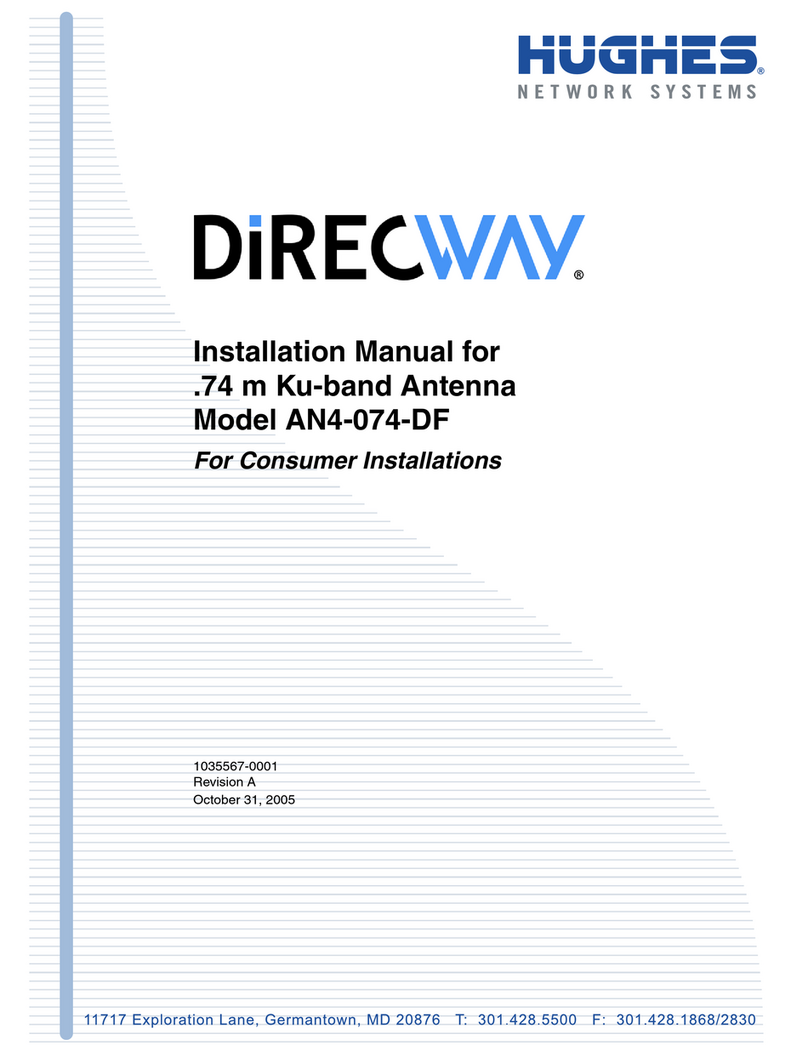
Hughes
Hughes DiRECWAY AN4-074-DF installation manual
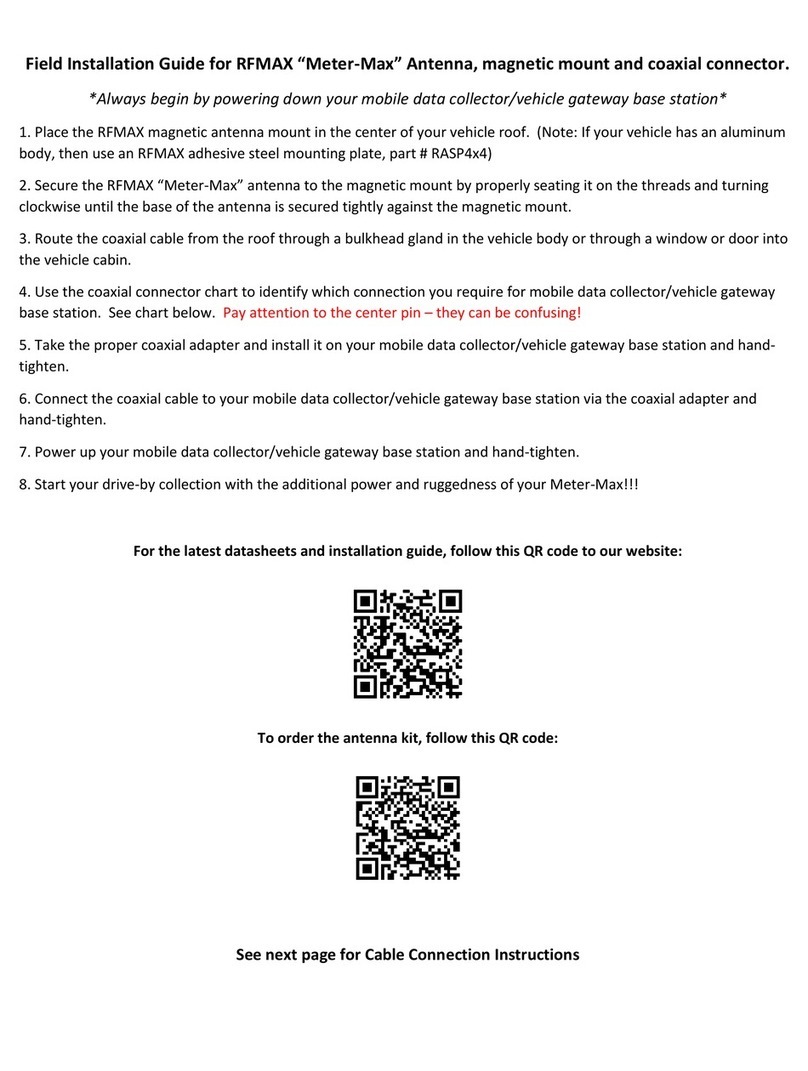
RF-Max
RF-Max Meter-Max installation guide

Panorama Antennas
Panorama Antennas LP MM Series installation instructions
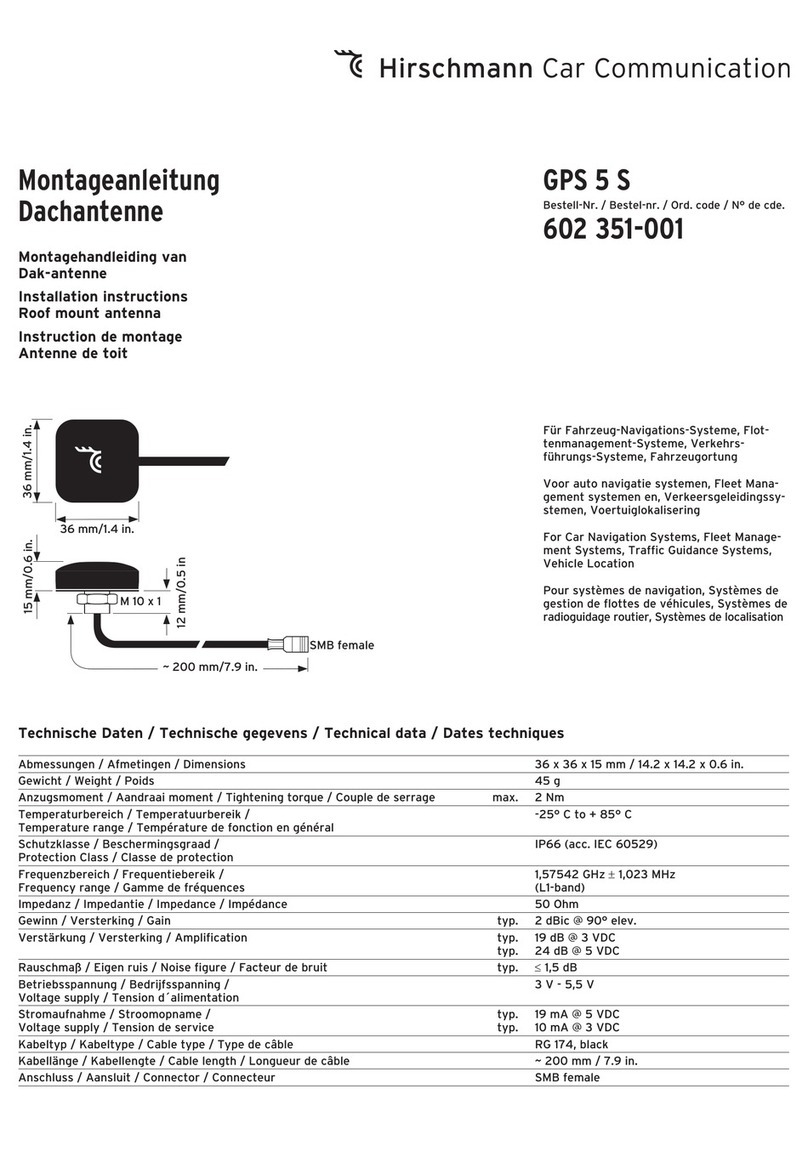
Hirschmann
Hirschmann GPS 5 S installation instructions
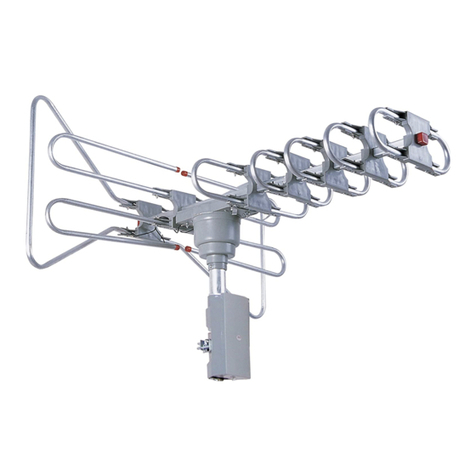
Supersonic
Supersonic SC-603 user guide
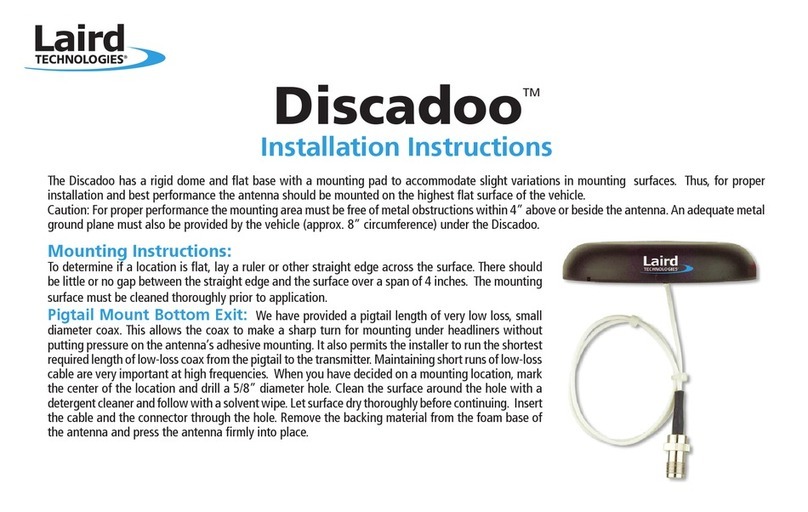
Laird
Laird Discadoo installation instructions
